

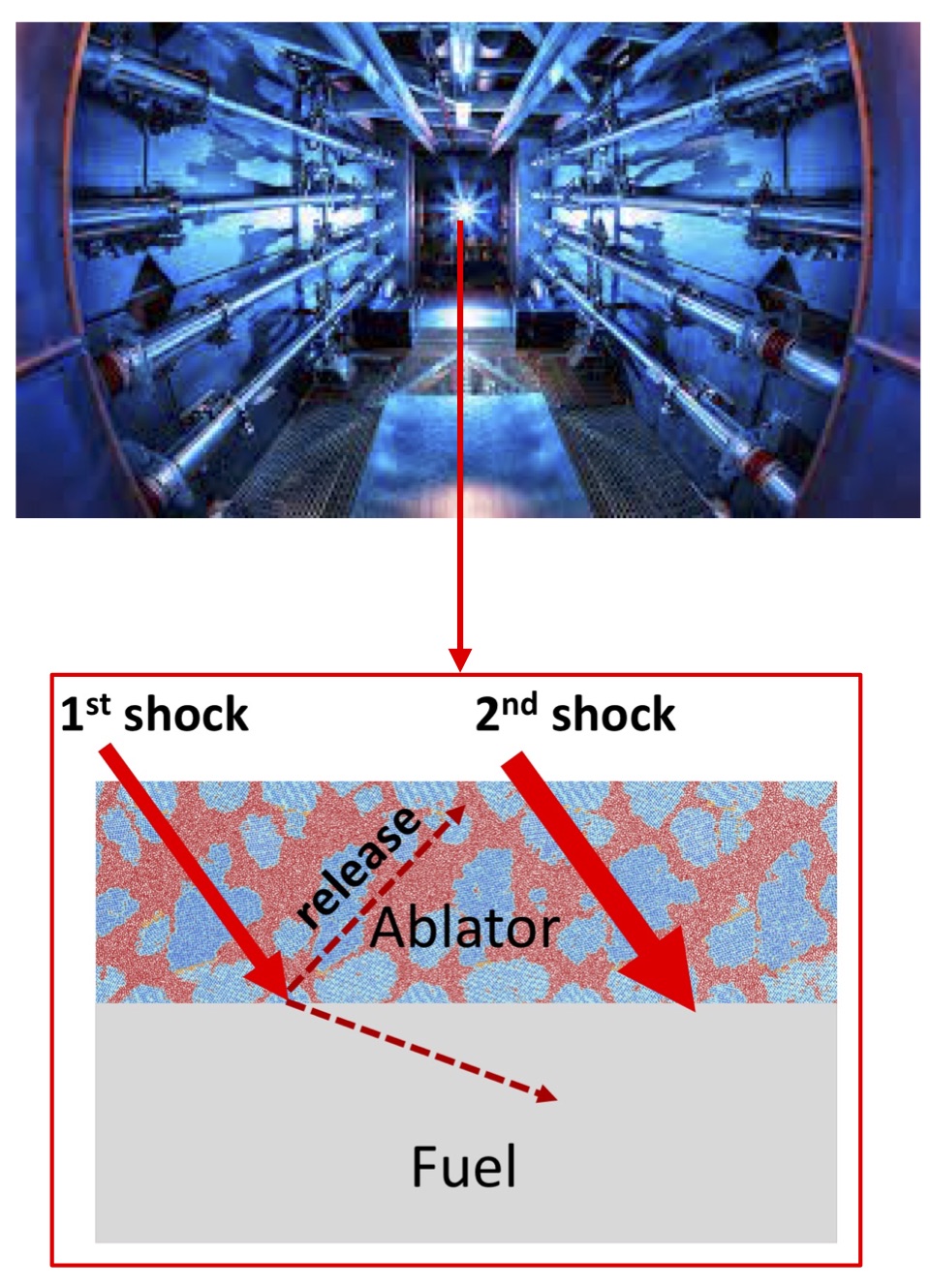
The historic December 5, 2022 experiment at Lawrence Livermore National Lab’s (LLNL) National Ignition Facility (NIF) achieved fusion ignition and paved the way to future clean inertial fusion energy (IFE). One of the key elements of inertial fusion energy (IFE) experiments is the ablative fuel capsule that is subjected to strong compression shocks to implode the fuel upon rocket-like blow-off of the material. Combining machine-learning molecular dynamics and experimental measurements, we investigate the high energy density physics of ablator materials under compression of IFE drivers. The scientific goals are (1) to uncover the atomic-scale evolution of the materials' microstructure; (2) to accurately describe the complex states of ablator materials; and (3) to obtain high-quality equation of state (EOS). This DOE-supported research involves collaborators from Carnegie’s Earth and Planets Laboratory and LLNL, and is backed by (1) a computational campaign at Frontier exascale supercomputer through DOE’s ASCR Leadership Computing Challenge (ALCC) award, and (2) an experimental campaign at Omega EP laser facility of the Laboratory for Laser Energetic via DOE’s LaserNetUS award.
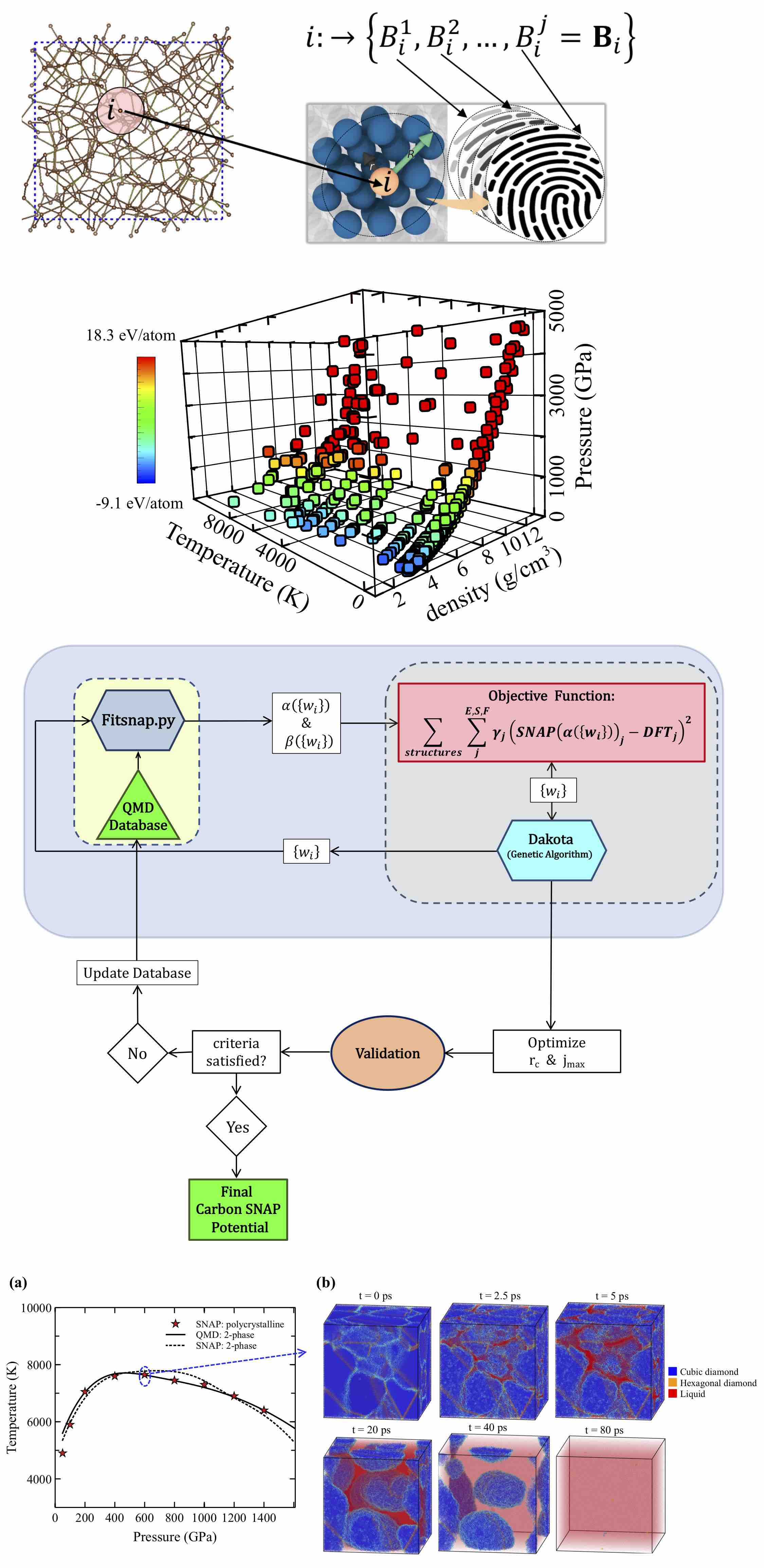
Molecular dynamics (MD) simulations have become an essential tool for investigating the physical and chemical behavior of materials under extreme conditions. By predicting the behavior of every atom in a system based on mathematical descriptions of interatomic interactions, MD provides a detailed atomic-scale understanding of material dynamics with fine time resolution, which is often unattainable through experiments. However, to enable transformative scientific discoveries, MD requires highly accurate models of how atoms interact with each other, almost as precise as those from quantum-mechanical density functional theory. MD also needs to simulate very large billion-atom systems with such quantum accuracy. To address these challenges, we are developing machine learning interatomic potentials (MLIPs) by (1) efficiently fingerprinting a unique local atomic environment around each atom using state-of-the-art descriptors, (2) employing a large database of experimentally relevant quantum molecular dynamics (QMD) data, (3) training the MLIPs with robust machine learning methodologies, and (4) extensively validating them against QMD and experimental data. The efficient implementation of these MLIPs on GPU-based exascale supercomputers enable us to perform quantum-accurate molecular dynamics simulations at experimental time and length scales, making a direct comparison with laser-driven dynamic compression experiments possible. The development of Machine Learning Informed Physics (MLIP) is a crucial component of each research project we undertake. It enables groundbreaking simulation campaigns at exascale supercomputers.
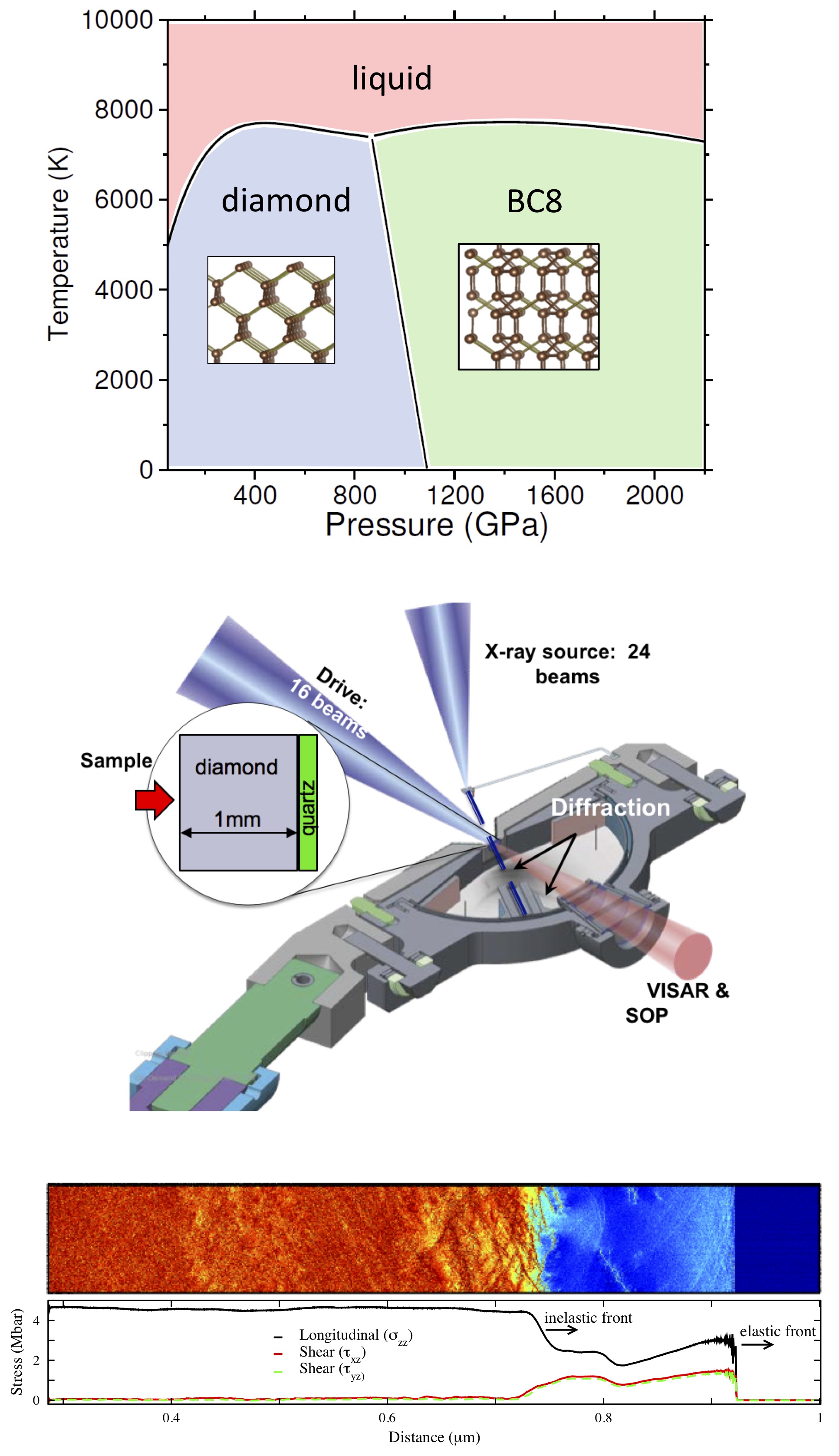
Properties of carbon at extreme pressures and temperatures are of critical importance for constructing interior models of carbon-rich exoplanets. Among the questions that have long perplexed the scientific community are the existence and potential synthesis of high-pressure post-diamond carbon phases, and the inelastic response of diamond to strong shock compression. In particular, very recent ramp compression and X-Ray diffraction experiments at the National Ignition Facility (NIF) challenged the theoretical prediction of the existence of a high-pressure BC8 post-diamond phase by compressing diamond to gigantic pressures up to 20 Mbar. In this project, we uniquely couple quantum-accurate, billion-atom MD simulations on exascale DOE computers with cutting-edge experiments at NIF to uncover the atomic-scale mechanisms and kinetics of solid-solid and solid-liquid phase transitions and nature of inelastic deformations in diamond. We also design the compression pathways towards the successful synthesis of the elusive post-diamond BC8 phase. The research is supported by DOE/NNSA and computational campaign at Frontier and Aurora exascale supercomputers through DOE’s The Innovative and Novel Computational Impact on Theory and Experiment (INCITE) and an experimental campaign via the NIF/LLNL Discovery Science program.
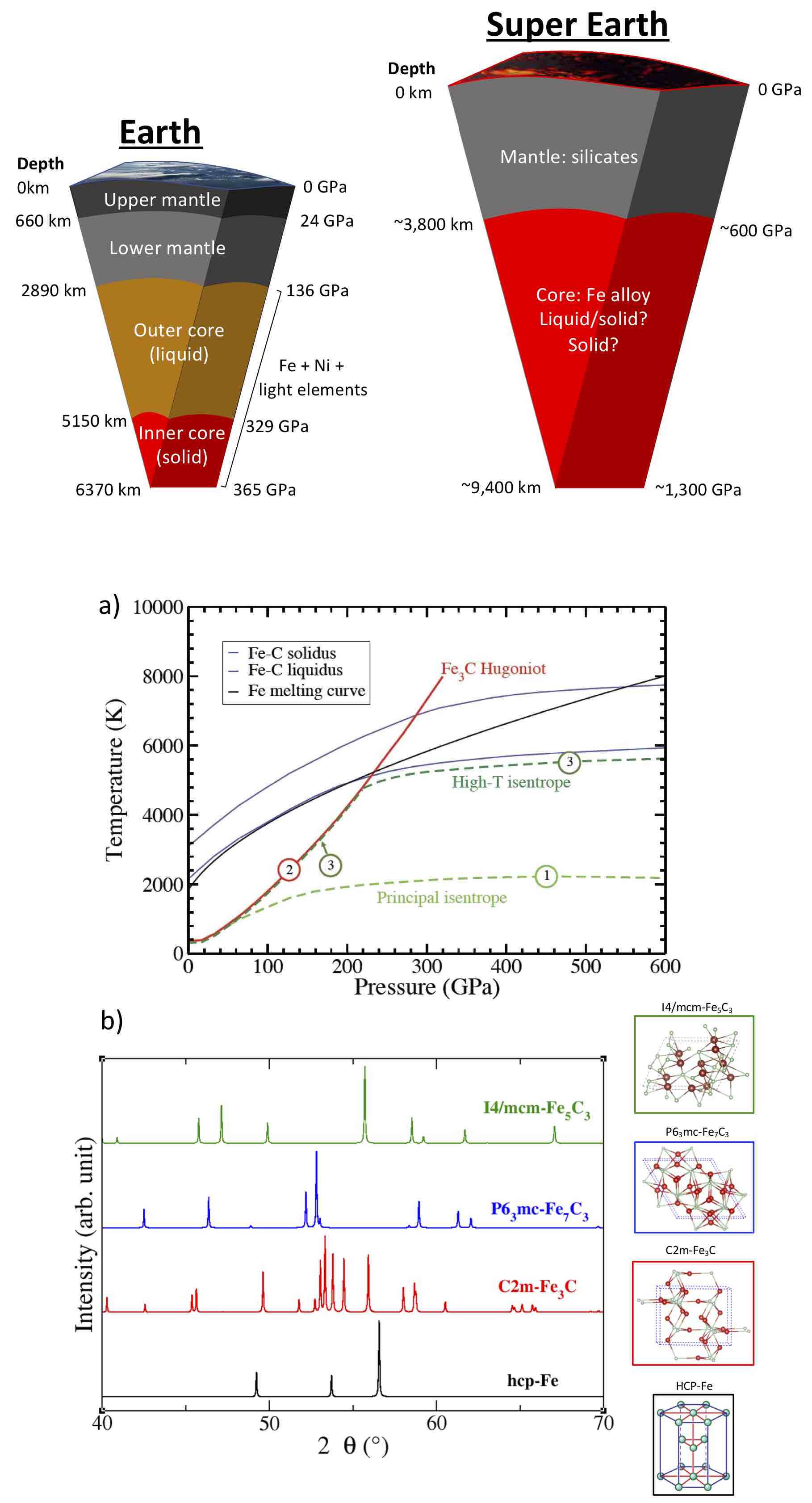
The Earth's core is composed of an iron-rich liquid outer core and a crystalline iron inner core, alloyed with lighter elements, experiencing extreme pressures of up to 360 GPa and temperatures of up to 6500 K. Recently discovered extrasolar planets are believed to have a similar chemical composition, with core pressures reaching up to 1300 GPa and temperatures as high as 10,000 K. Due to its cosmochemical abundance and prevalence in Fe meteorites, carbon is considered a likely light alloying element in the Fe cores of Earth and other rocky exoplanets. However, the lack of data on carbon incorporation into an iron core makes it challenging to model the interior structure and thermal evolution of these planets. To address this challenge, we are investigating the phase stability and equation of state of iron carbides under extreme pressure and temperature conditions through a combination of molecular dynamics simulations and dynamic compression experiments. Our ultimate goal is to provide accurate data to establish improved models of the structure, formation, and evolution of the cores of Earth and carbon-rich exoplanets. This research involves collaborators from Carnegie’s Earth and Planets Laboratory and LLNL and is supported by DOE/NNSA, as well as computational and experimental campaigns at the exascale Frontier supercomputer (INCITE and ALCC awards) and the Omega EP laser facility at LLE (NLUF award).
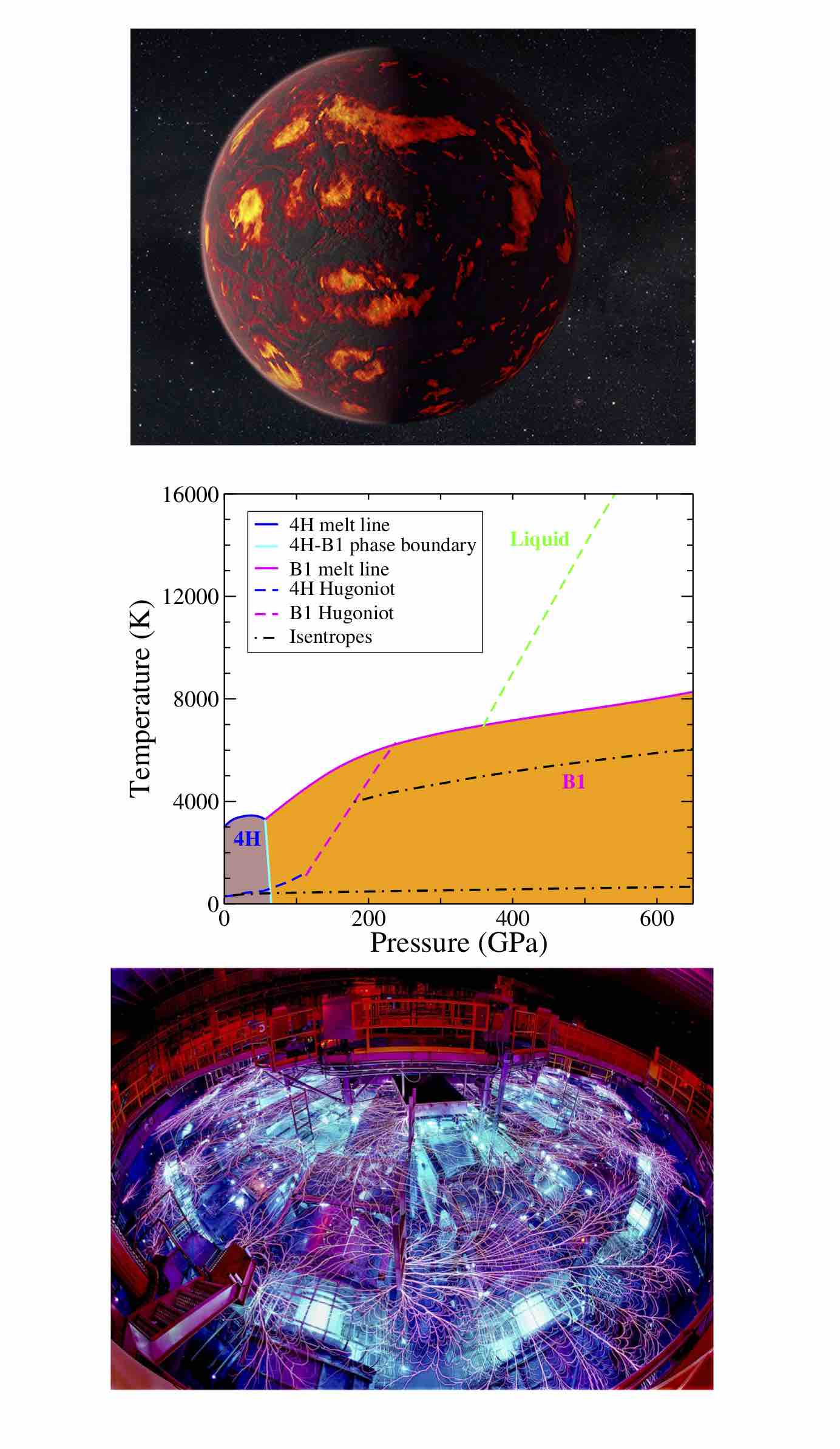
Recent astrophysical observations have indicated a potential existence of carbide-rich exoplanet. This project that aims to understand the high pressure, high temperature behavior of silicon carbide (SiC) and obtain key geophysical data for the development of interior models for carbon-rich exoplanets. We combine predictive molecular dynamics simulations with experiments at the Z pulsed-power and STAR gas gun facilities to investigate the mechanisms of solid-solid and solid-liquid phase transitions in SiC. The goals of the project include delivering accurate equations of state for the solid and liquid phases of SiC, determining the melting lines of SiC phases, exploring the possibility of incongruent melting, and uncovering the effect of significant volume collapse on the kinetics of the ambient B3 to high-pressure B1 phase transition. The research is performed in collaboration with Sandia National Laboratories (SNL) and is supported by the Z Fundamental Science program and computational and experimental campaigns at DOE's Frontier and Aurora exascale supercomputers, as well as the Z pulsed power and STAR gas gun facilities at SNL.